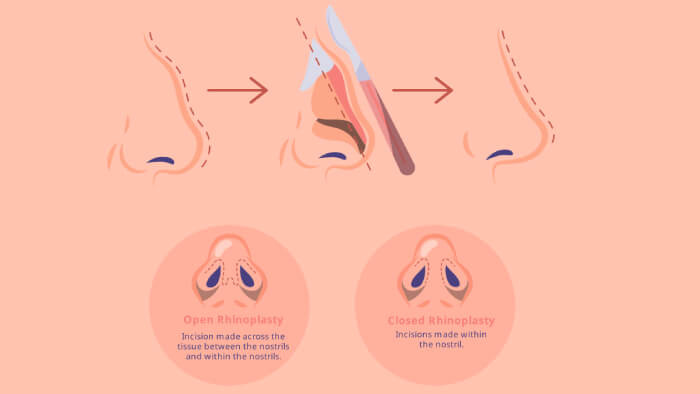Understanding common terminology for rhinoplasty
Rhinoplasty is a complex and intricate field within cosmetic surgery. For those contemplating this procedure or interested in the subject, the specialized terminology used can often seem bewildering. The language of rhinoplasty is rich and specific, comprising terms that describe various parts of the nose, surgical techniques, and desired outcomes. A clear understanding of these terms not only enhances one's comprehension of the procedure but also fosters a sense of empowerment. Understanding these terms is crucial, as it not only demystifies the process but also enables patients to make informed decisions and communicate effectively with their healthcare providers. In this article, we will expand on some of the key terms used in rhinoplasty.

Rhinoplasty
The medical term for nose reshaping surgery, aimed at improving the nose's appearance or function. Rhinoplasty, is a surgical procedure designed to alter the shape, size, or structure of the nose for either cosmetic or functional reasons. Whether addressing aesthetic concerns like a hump or asymmetry, or functional issues such as a deviated septum, the surgery involves reshaping the bone and cartilage to achieve the desired outcome.
Septorhinoplasty
A combination of rhinoplasty and septoplasty, septorhinoplasty corrects both the external shape of the nose and internal septum issues. This procedure addresses cosmetic aspects and functional concerns, reshaping bone and cartilage for aesthetic enhancement and correcting any structural abnormalities in the nasal septum for improved breathing. Septorhinoplasty offers a comprehensive solution for individuals dealing with both cosmetic and breathing difficulties associated with a deviated septum.
Septum
The wall of cartilage and bone that divides the nostrils. A deviated septum, when off-center, can cause breathing difficulties. A well-aligned septum facilitates optimal airflow, but a deviated one can lead to issues like congestion and difficulty breathing. Surgical interventions like septoplasty or septorhinoplasty may be considered to correct the alignment and restore nasal health when it affects both form and function.
Columella
The columella, a crucial component of nasal anatomy, is the fleshy divider between the nostrils, comprised of cartilage and skin. Playing a significant role in nasal aesthetics and function, its size and shape influence the overall appearance of the nose. In rhinoplasty, surgeons may adjust the columella to enhance symmetry and refine proportions for improved cosmetic outcomes. Additionally, as the housing for the nasal septum, alterations aim for a harmonious balance between form and function. Consideration of the columella's anatomy is essential for optimal results in both cosmetic and functional aspects of nasal surgery.
Open rhinoplasty
In open rhinoplasty, an incision is made across the columella, providing direct access to the nasal structures for complex procedures. This approach is chosen for intricate adjustments to bone and cartilage, allowing for precise cosmetic refinements and functional corrections. Despite the visible incision, the carefully placed scar minimally impacts overall aesthetics, making it suitable for cases where thorough examination and precision are crucial.
Closed rhinoplasty
This approach involves manipulating the bone and cartilage through discreet internal incisions, providing access for reshaping without visible scarring. Closed rhinoplasty is often chosen for cases that require less extensive modifications, making it a suitable option for patients seeking subtle cosmetic enhancements or minor functional corrections. While the closed technique offers the advantage of no external scarring, it may have limitations in terms of visibility and access compared to open rhinoplasty. The choice between closed and open techniques depends on the specific goals of the surgery and the complexity of the adjustments needed.
Tip plasty
A procedure focusing specifically on reshaping the tip of the nose, without altering the rest of the nasal structure. Chosen by those seeking specific improvements in tip shape, projection, or symmetry, the technique involves precise adjustments to cartilage, angle, and symmetry. It is beneficial for individuals dissatisfied with their nasal tip aesthetics, providing facial harmony without the need for extensive adjustments to the entire nose. Known for its precision, tip plasty enhances facial balance, creating a natural and pleasing appearance.
Hump reduction
This refers to the removal or reduction of a bump on the nasal bridge, a common request in rhinoplasty. During the procedure, the surgeon carefully removes or reshapes excess bone and cartilage, resulting in a smoother and more streamlined nasal profile. Hump reduction is ideal for those looking to achieve a more balanced and harmonious appearance by addressing a prominent feature on the nose. The procedure is known for its effectiveness in achieving subtle yet impactful changes, creating a natural and refined look.
Alar base reduction
A procedure to narrow the width of the nostrils. It's often performed in ethnic rhinoplasty to maintain natural features while enhancing the nose's overall appearance. The surgeon makes carefully placed incisions to remove or reshape excess tissue, achieving a narrower and more aesthetically pleasing nasal base. Alar base reduction is valued for its ability to enhance overall facial harmony by creating a subtle yet impactful change in the width of the nostrils, resulting in a refined and natural look.
Nasal osteotomy
A surgical technique involving the cutting and reshaping of nasal bones, usually to narrow the bridge or close an open roof after hump reduction. This precise procedure involves carefully controlled bone cuts, allowing surgeons to alter the nasal structure for both cosmetic and functional purposes. Osteotomy is often employed to address issues such as nasal width, asymmetry, or to straighten a deviated septum. By strategically adjusting the bones, surgeons can achieve a more harmonious and balanced nasal appearance, enhancing overall facial aesthetics. This technique is valued for its ability to create subtle yet impactful changes, contributing to a refined and natural-looking result.
Cartilage grafting
This involves taking cartilage from another part of the body, like the ears or ribs, and using it to add structure and support to the nose.Surgeons strategically place the cartilage grafts to provide additional support, reshape the nasal framework, or enhance overall symmetry. Common donor sites for cartilage include the septum, ear, or rib. The versatility of cartilage grafting makes it a valuable tool in achieving optimal aesthetic outcomes and functional improvements during rhinoplasty procedures.
Revision rhinoplasty
A secondary surgery performed to correct or improve the results of a previous rhinoplasty. It addresses both aesthetic and functional concerns that may persist, such as dissatisfaction with the initial outcome or breathing difficulties. This specialized form of rhinoplasty requires careful evaluation and skilled techniques to achieve improved nasal appearance and functionality.
Non-surgical rhinoplasty
Non-surgical rhinoplasty, also known as liquid rhinoplasty, is a minimally invasive cosmetic procedure that enhances the appearance of the nose without the need for surgery. During this procedure, dermal fillers, typically composed of hyaluronic acid, are strategically injected to reshape or augment specific areas of the nose. The procedure offers a quicker recovery compared to traditional rhinoplasty, and results are often visible immediately. While non-surgical rhinoplasty provides temporary enhancements, it can be an attractive alternative for those looking for subtle changes without the commitment and downtime associated with surgical interventions.
Conclusion
Navigating the world of rhinoplasty requires a grasp of the specific language that defines its procedures and outcomes. This glossary serves as a key to unlocking a deeper understanding of one of the most intricate and personalized forms of cosmetic surgery. By familiarizing themselves with these terms, individuals considering rhinoplasty can engage in more meaningful and productive dialogues with their surgeons. This not only ensures clarity in communication but also helps in forging a mutual understanding of the aesthetic goals and the realistic outcomes of the surgery.


